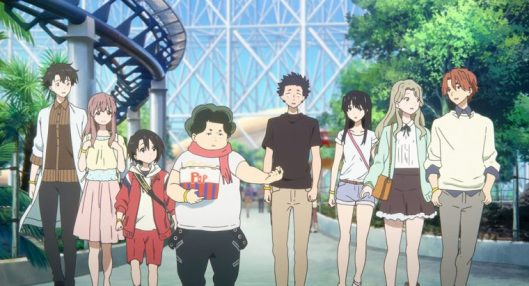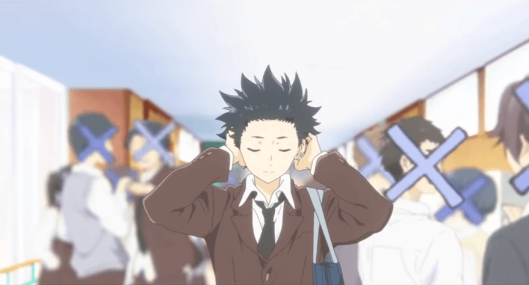Rather than romance, the greatest themes of Koe no Katachi (A Silent Voice) were friendship and redemption. It tackled the complexity of people and the struggle to fix fragile ties in friendship.
Note: This post is a revised (spoiler-free) version of the one I published earlier on thechaserofdreams.wordpress.com.
Synopsis
Nishimiya Shoko, a deaf girl, transfers into Ishida Shoya’s elementary school class. After getting tired of helping Nishimiya all the time, the class starts to bully her, especially Ishida. However, when the bullying turns extreme, the class begins to bully Ishida instead. Nishimiya tries to help him, but he retaliates and they get into a fight, resulting in Nishimiya transferring schools and Ishida being isolated by his classmates and friends. The two do not meet after that, but in middle school, Ishida decides that he needs to meet Nishimiya again to make up for his past misdeeds and be her friend.
Opening Plot
The beginning of the movie was quite painful to watch. We see Ishida in the present, getting his pay, withdrawing his the money from his bank account, and the crossing out of the calendar. A flashback to the past explains Ishida’s situation and his complex behaviour in the past. While Ishida helped to stand up for Nishimiya when some of his classmates (Ueno and Kawai) were criticising her, and even suggested that she should try harder to communicate with the class, he turned hostile after Nishimiya indicated that she wanted to be his friend. That was the start of Ishida bullying Nishimiya, and it got more extreme when Ishida started snatching and destroying her expensive hearing aids. Ishida’s complex and extreme behaviour was baffling to me as he switched sides so quickly, and even became the greatest bully.
Theme: Redemption

Source: https://coub.com/view/f6rgz
The movie portrayed Ishida’s growth in maturity as he learnt that suicide was not the key to removing the guilt in his heart. He kept Nishimiya’s ‘For Conversation’ notebook in order to return it to her and learns sign language in order to be able to communicate with her. After meeting Nishimiya at a sign language school by chance, Ishida tried to be her friend. However, he faced the opposition of Yuzuru, who sternly told him to stop going over to the sign language class if he just wanted to make himself feel better by doing so. That threw a deeply disconcerting impact. One’s efforts to redeem oneself certainly could be seen as a selfish act – to do something good not for the person on the receiving end, but in order to comfort oneself. Despite that, it was significant that Ishida did become friends with Nishimiya. His growth was evident in how he faces others – no longer did he see ‘crossed out’ faces, but obtained the courage to move on and cross the boundary he draws between himself and others. Ishida’s social circle gradually increased involving his middle school classmates, starting with Nagatsuka.
Side Characters

From right to left: Sahara, Nishimiya, Yuzuru, Nagatsuka, Ishida, Ueno, Kawai, Mashiba Source:https://cinema.ne.jp/news/koenokatachi2016091016/
Minor signs of redemption could be seen in the side characters as well, though these tended to be quite messy. Perhaps it was because this was a movie adaptation of a manga that some parts felt quite rushed. For example, the ‘strange’ group’s trip to the amusement park was really weird. Sure, Ishida going with Nishimiya, Nagatsuka, Yuzuru and Sahara was understandable because they have started to know one another quite well. Nagatsuka proclaimed Ishida to be his best friend. Ishida became friends with Yuzuru and (perhaps) Sahara because of their connections with Nishimiya. On the other hand, Kawai, Mashiba and Ueno did not really fit. While Ishida did start talking to Kawai, it did not feel like they became close enough to be friends. Also, I felt that Mashiba was a random ‘extra’, being somebody who only knew Ishida in middle school, and not really a friend. He just somehow joined the group because he was Kawai’s boyfriend.
Ueno was the second most complex character, with the first being Ishida. Although she wanted to help stand up for Ishida as an apology of her past betrayal, she still hated Nishimiya. As for Kawai, I was somehow always critical of her. She seemed really superficial and constantly acted as the victim, despite laughing along when Nishimiya was being bullied. I was critical of her all the way until the end, when she gave Ishida the cranes. Personally, I found Sahara’s character very relatable. She wanted to help Nishimiya but ultimately ran away by transferring schools when she was bullied as well. As Ishida later pointed out, Sahara was still a coward despite acting like she was now brave enough even to enjoy riding a rollercoaster.
Despite the drama, Koe no Katachi did not forget about humour. The funniest parts were Yuzuru’s identity, Nyan Nyan Cafe and Nishimiya’s failed confession. The first two garnered the most laughter in the cinema theatre I was in.
All in all, Koe no Katachi reminds us to come to terms with our past and continue moving forward. It is certainly very thought-provoking. The complexity of the characters reflect the complexity in ourselves, like how we sometimes struggle between doing what is right and wrong, and suddenly decide to shut everyone out at times. The struggles and fragile ties in friendship are beautifully played out, making the movie very relatable.
Watch the trailer here: https://youtu.be/9aRexOtovXY
Note: The names I have used are the family names of the characters because they are more commonly referred to that way in the movie, with the exception of Yuzuru.


